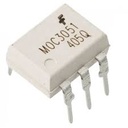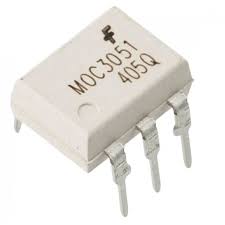MOC3051 optocoupler
This content will be shared across all product pages.
The MOC3051 is an optically isolated triac driver optocoupler designed to interface low voltage control signals to high voltage AC loads. It provides electrical isolation between the input and output circuits and is capable of controlling AC loads directly. This optocoupler integrates an infrared LED and a zero-crossing triac driver, making it suitable for applications such as solid-state relays, motor controls, and lamp dimmers.
Key Features:
- Optically isolated triac driver
- Zero-crossing circuitry
- High isolation voltage
- Low input current requirements
- Compact 6-pin DIP package
- High surge current capability
- Long operational life
- Isolation Voltage: 5000 VRMS (1 minute)
- LED Forward Voltage: 1.2V (typical)
- LED Forward Current: 10mA (max)
- Output Peak Blocking Voltage: 400V
- Trigger Current (IFT): 10mA (max)
- Holding Current: 100µA (max)
- Operating Temperature Range: -40°C to +100°C
- Package: 6-pin DIP
- Solid-State Relays: Provides isolation and control in solid-state relay circuits for switching AC loads.
- Lamp Dimmers: Used in light dimmer circuits for smooth and efficient control of lamp brightness.
- Motor Control: Provides isolation and control in motor drive circuits for industrial and consumer applications.
- AC Load Switching: Used in circuits that require reliable switching of AC loads with electrical isolation.
- Home Appliances: Ensures safe and efficient control in various home appliances requiring AC switching.
- Industrial Automation: Provides isolation and control in industrial automation systems.
Technical Specifications:
- Logic Family: CMOS
- Number of Channels: 3
- Switch Configuration: Single-Pole Double-Throw (SPDT)
- Supply Voltage Range: 3V to 15V
- “ON” Resistance (R_ON): 125Ω typical at V_DD = 10V
- “OFF” Leakage Current (I_OFF): ±100pA typical at V_DD = 10V
- Control Input Voltage (V_IH): 0.7 V_DD min, 0.3 V_DD max
- Maximum Operating Frequency: 40 MHz at V_DD = 10V
Applications:
- Signal routing and switching
- Analog and digital multiplexing
- Audio and video signal processing
- Data acquisition systems
- Test equipment


